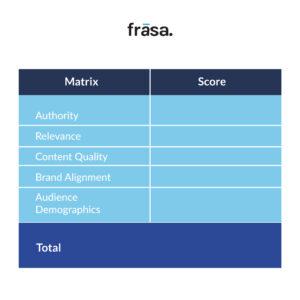In recent years, influencers have emerged as powerful marketing tools. Their ability to connect with audiences on a personal level and their authenticity have made them highly sought-after by brands. As the influencer market has grown, so has the complexity of selecting the right individual to represent a brand.
Brands are faced with a daunting task: sifting through a sea of influencers to find the perfect match. The sheer number of influencers, coupled with the diverse range of niches, can make the decision-making process overwhelming. Factors such as follower count, engagement rate, audience demographics, and alignment with brand values all need to be carefully considered.
This is where influencer score cards come in.
An influencer scorecard is a systematic method for evaluating potential influencer partners. It assigns scores to influencers across various categories that are relevant to a brand’s marketing goals. These categories typically include:
Authority: This evaluates the influencer’s expertise and credibility within their niche.
Relevance: This measures how well the influencer’s content aligns with the brand’s target audience and industry.
Content Quality: This evaluates the overall quality of the influencer’s content, including its creativity, originality, and visual appeal.
Brand Alignment: This assesses how well the influencer’s personal brand aligns with the brand’s values and messaging.
Audience Demographics: This assesses the influencer’s follower base in terms of age, location, gender, interests, and other relevant characteristics.

Influencer Marketing Socrecard to measure the compatibility with your brand
So, how do you use these scorecards?
Basically, you can just give rates between 1 and 5 on each matrix in this table. So the higher the score an influencer gains, the higher the chance it can work well with your brand.
If you’ve already got the score and have reached the decision to do the collaboration, here are some collaboration ideas you might try in 2024:
- Micro-influencer partnerships:
- Why: Micro-influencers, with smaller but highly engaged followings, often have a more authentic connection with their audience.
- Benefits: Higher engagement rates, lower costs, and a more targeted reach.
- Ideas: Long-term partnerships, product reviews, and exclusive discounts.
- Nano-influencer partnerships:
- Why: Nano-influencers, with even smaller followings, often have the most intimate connection with their audience.
- Benefits: Extremely targeted reach, highly personalized content, and cost-effective.
- Ideas: Takeover days, behind-the-scenes content, and word-of-mouth marketing.
- Co-branded products:
- Why: Create a stronger connection between the brand and the influencer.
- Benefits: Tap into their audience’s trust and loyalty to promote their products or services.
- Ideas: A clothing brand partnering with a lifestyle influencer to create a co-branded line of apparel.
Exploring these various collaboration types can effectively leverage the power of influencer marketing to reach their target audience, build brand awareness, and drive sales in 2024.
Found this article helpful?
Share it with your network to help others discover the secrets to successful influencer marketing. And stay tuned for more valuable insights and tips.